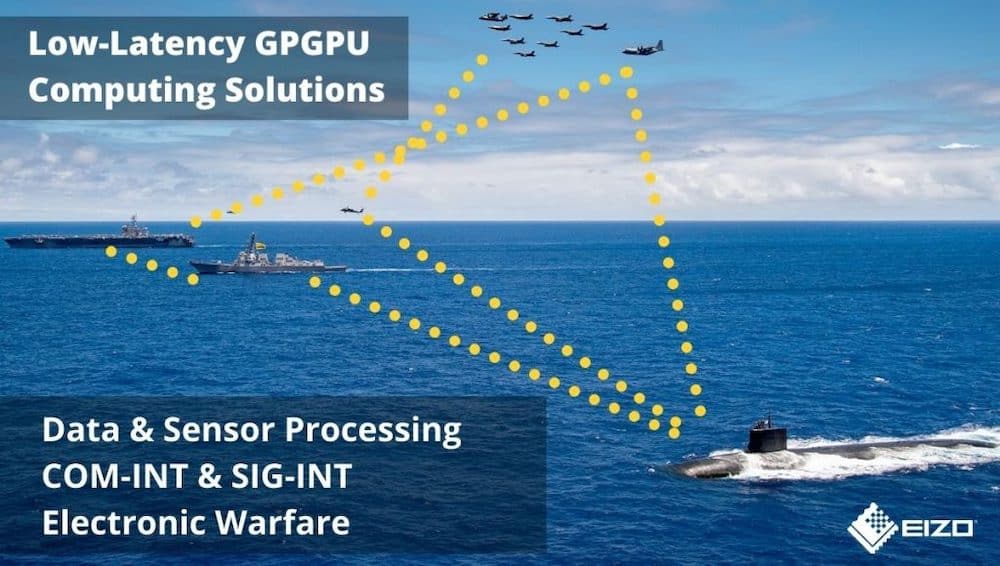EIZO Rugged Solutions has released an article that explains the use of embedded GPGPUs in military Signals Intelligence (SIGINT) applications for edge computing capability.
Military Signals Intelligence (SIGINT) embedded systems are designed to gather and analyze signals, or electronic communications. SIGINT plays a critical role in military operations by providing real-time intelligence on enemy activities and locations, allowing for improved decision-making and tactical advantage. In addition, SIGINT systems can be used for counterintelligence and cybersecurity to gather information on the communications and activities of foreign intelligence agencies, providing important counterintelligence information.
Overall, the goal of SIGINT systems is to provide actionable intelligence to military decision-makers in real-time, to support tactical and strategic operations.
Examples of SIGINT systems include:
- Electronic surveillance systems that collect and analyze signals from enemy communications and radar systems
- Signals intelligence satellites that use advanced sensors to gather signals from space.
- SIGINT ground stations that receive and process signals from airborne platforms, such as unmanned aerial vehicles (UAVs).
- Mobile SIGINT systems, such as ground vehicles and portable devices, that are deployed in the field to gather and process signals in real-time.
Processing Systems Used In SIGINT Systems
The high-performance embedded computing (HPEC) processing systems used in SIGINT applications are designed to handle large amounts of data and perform complex computations in real-time, enabling rapid decision-making and effective operations. There are several types of processing systems deployed within SIGINT applications such as System-on-Module (SoMs), General-Purpose Graphics Processing Units (GPGPUs), Field-Programmable Gate Arrays (FPGAs), and Digital Signal Processing (DSP) systems.
Edge GPGPUs are used for sensor processing in ISR applications, such as SIGINT systems for several reasons, including:
- Low Latency: Edge GPGPUs can perform real-time, high throughput processing of sensor data at the edge, reducing latency and ensuring timely delivery of information.
- Large data sets: SIGINT data often involves large and complex data sets that traditional computing systems may struggle to process in a timely manner. GPGPUs are designed to handle these types of data sets.
- Improved performance: By offloading data processing to a specialized processor, edge GPGPUs can help to improve the overall performance of the embedded system.
- Parallel Processing: GPGPUs are designed for parallel processing, allowing for efficient and fast processing of large amounts of SIGINT data.
- Cost-effectiveness: GPGPUs can be more cost-effective than traditional computing systems for certain types of processing tasks, making them a suitable choice for SIGINT systems that need to perform complex computations at the edge.
With GPU architectures such as NVIDIA’s CUDA platform you can easily scale up or down depending on system requirements – meaning that if you need more computing power at one time then simply add an additional GPU card and continue working as usual without having to worry about compatibility issues or performance degradation.
EIZO Rugged Solutions offers many different commercial off-the-shelf (COTS) video graphics and GPGPU processing solutions designed for C5ISR SIGINT applications. Our solutions are available in various form factors such as 3U/6U OpenVPX, XMC, and in PCI Express, and support NVIDIA’s latest GPUs including the NVIDIA® RTX 3000/5000 (Turing Architecture), and the NVIDIA RTX A2000 and RTX A4500 (Ampere Architecture).
All our designs are scalable and feature open architecture designs encompassing the latest HPEC requirements such as support for PCI Express Gen 4, AI Interface, 40/100 Gbps Ethernet with RoCE, CUDA®/OpenCL™ and Vulkan compute capabilities. Our OpenVPX GPGPU solutions are designed in line with VITA 46 and VITA 65 standards, as well as adhere to CMOSS, VICTORY, and SOSA technical standards.
The Condor line of NVIDIA GPU-based products enables access to AI Inference, multi sensor processing, video displays as well as enabling additional feature sets like video DMA capture and metadata processing.
The Condor GPU processing cards are ideal for a range of compute-intensive applications such as image analysis, image enhancement, 360° video stitching, sensor fusion, and much more.
All Condor products are customizable with various I/O configurations such as 3G-SDI, HD-SDI, DVI, HDMI, DisplayPort, VGA, RS-343, STANAG 3350, ARINC 818, CoaXPress, and CVBS (NTSC/PAL).










